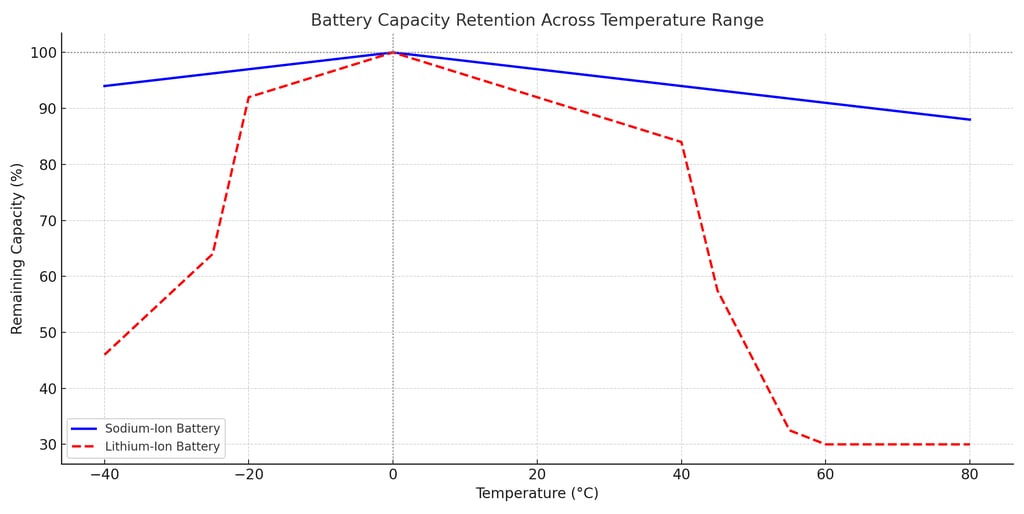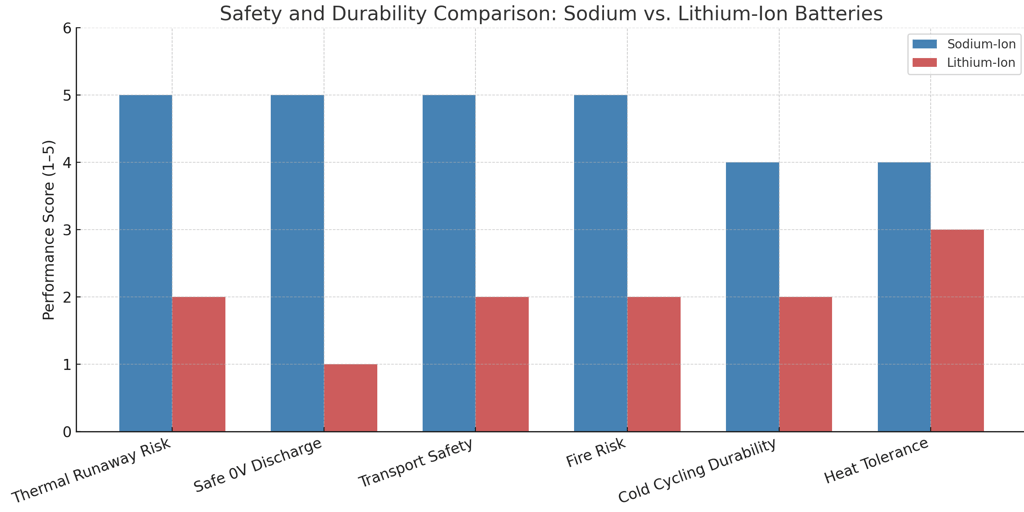Sodium-Ion vs. Lithium-ion Battery - Performance in Extreme Temperatures
Focus on Stationary Storage
Mika Kuosmanen, CTO
4/16/20253 min read


Introduction
Sodium-ion batteries (Na-ion) have emerged, from being a promising alternative, to being a real contender to lithium-ion (Li-ion) batteries, especially in the field of stationary energy storage as it possesses numerous superior qualities. One of the key advantages driving this shift is the ability of sodium-ion batteries to operate reliably in both extremely cold and extremely hot environments, while still maintaining its performance at a good level. In contrast, the perfomance of a lithium-ion battery is typically optimised within moderate temperatures (~15–35 °C), and both their capacity and lifespan tend to deteriorate significantly in extreme conditions.
This report analyses the performance of sodium-ion batteries versus lithium-ion batteries in extreme temperatures, while focusing on:
Operating temperature ranges
Capacity retention
Cycle life
Safety considerations
Suitability for northern climates
The information is based on technical specifications, peer-reviewed studies, and authoritative sources such as IEA, Nature Energy, and battery manufacturers.
1. Operating Temperature Ranges
Sodium-ion batteries: Sodium-ion batteries typically operate between -20 °C and +60 °C, with some designs - like the ones we at G.E.S. provide - extend that range to -40 °C and +80 °C. For instance, CATL’s first-gen sodium-ion cell retained 90% of its rated capacity at -20 °C (OneCharge), and other sources reported operation down to -40 °C without major safety risks (Nature Energy).
Lithium-ion batteries: Lithium-ion batteries typically operate within -20 °C to +60 °C but function optimally between +15 °C and +35 °C. Below -20 °C, both capacity and power output drop sharply. Charging below 0 °C can cause lithium plating and permanent damage. At temperatures above +60 °C, the risk of thermal runaway increases due to electrolyte decomposition (Battery University).




2. Capacity Retention in Cold and Hot Temperatures
Cold temperatures: Sodium-ion batteries retain more usable capacity in cold conditions. Studies show up to 90% retention at -20 °C (OneCharge), whereas lithium-ion batteries may fall to 70% or less in the same conditions. Below -30 °C, lithium-ion batteries can lose over 50% of usable capacity, while sodium-ion cells may still perform at ~80%.
Hot temperatures: Lithium-ion batteries degrade rapidly in high heat. Above 40–50 °C, side reactions and electrolyte breakdown reduce life span. Sodium-ion cells demonstrate greater thermal stability and retain functionality up to +80 °C, with thermal decomposition reactions occurring ~90 °C higher than in Lithium-ion equivalents (MDPI Nanomaterials).
3. Cycle Life in Extreme Conditions
Cold cycling: Lithium-ion batteries suffer permanent capacity loss when cycled in freezing temperatures due to lithium plating. Sodium-ion batteries don’t have this issue. While performance per cycle is lower at extreme cold, sodium-ion chemistry is less prone to internal damage. Experimental sodium-ion cells have maintained 60% capacity at -20 °C over multiple cycles (MDPI Nanomaterials).
Hot cycling: Lithium-ion cells suffer accelerated degradation above 40–50 °C. Sodium-ion batteries can tolerate high temperatures better, thanks to more stable cathode/anode materials and electrolytes, though all chemistries benefit from thermal management in long-term use.
4. Safety
Thermal runaway and fire risk: Lithium-ion batteries are known for their risk of thermal runaway when overcharged, overheated, or physically damaged. Sodium-ion cells are more thermally stable, use less flammable electrolytes, and are less prone to runaway reactions. Nail penetration and overcharge tests show sodium-ion cells do not easily ignite, even when fully charged (Faradion).
Deep discharge and transport: Sodium-ion cells can be discharged to 0V safely, which improves transportation safety and shelf life. Lithium-ion batteries, on the other hand, must be stored at partial charge and can be damaged by deep discharge due to copper collector dissolution (Faradion).
5. Suitability for Northern Climates
In Northern Europe and similar cold climates, sodium-ion batteries present a major advantage. Their ability to retain capacity without external heating makes them ideal for outdoor or uninsulated installations. This reduces system complexity and energy losses. Lithium-ion systems, by contrast, typically require heating and insulation to function effectively in sub-zero conditions (OneCharge).
In high temperatures, sodium-ion batteries are also more stable, requiring less active cooling. Their fire safety and cold-weather operability make them an ideal match for grid-connected energy storage in harsh climates.
Comparative Summary Table
Conclusion
Sodium-ion batteries provide superior thermal resilience compared to lithium-ion in both cold and hot environments. Their ability to retain performance in extreme temperatures makes them well-suited for grid storage in northern and variable climates. Additionally, their safer chemistry, stable materials, and lower fire risk make them a promising next-generation alternative for sustainable, scalable energy storage.
They are not only cost-efficient and abundant in raw materials – they are ready for real-world conditions.
Address:
Grid Energy Storages (G.E.S.) Oy
Kampinkuja 2
00100 Helsinki
FINLAND
Email:
© 2025 Grid Energy Storages (G.E.S.) Oy (Business ID: 3516951-9). All Rights Reserved.


